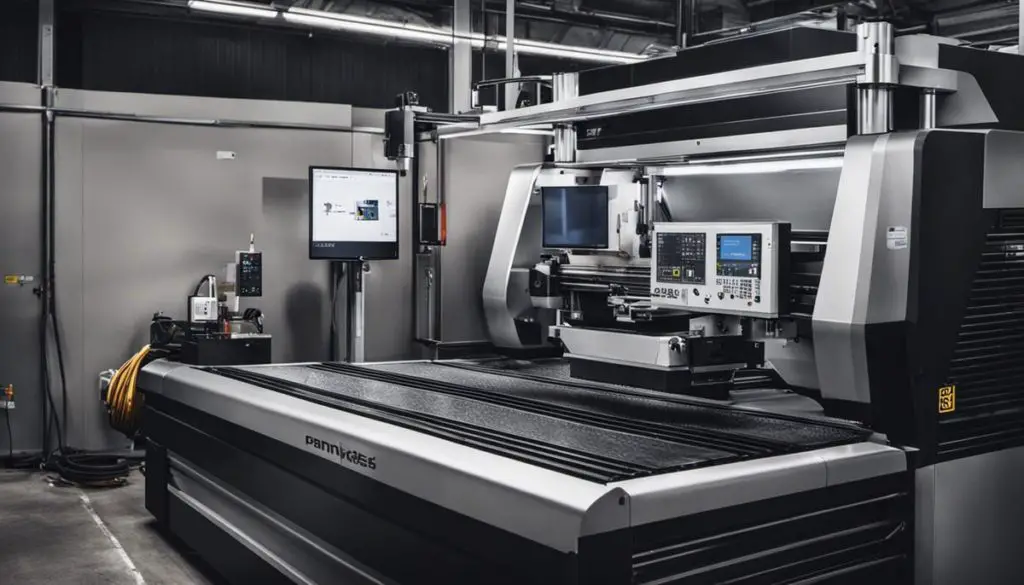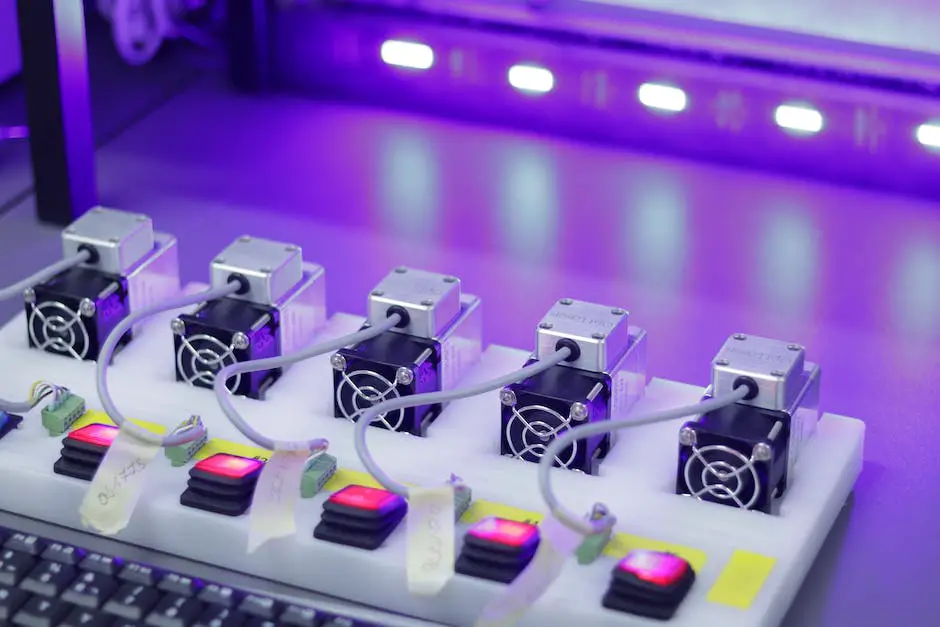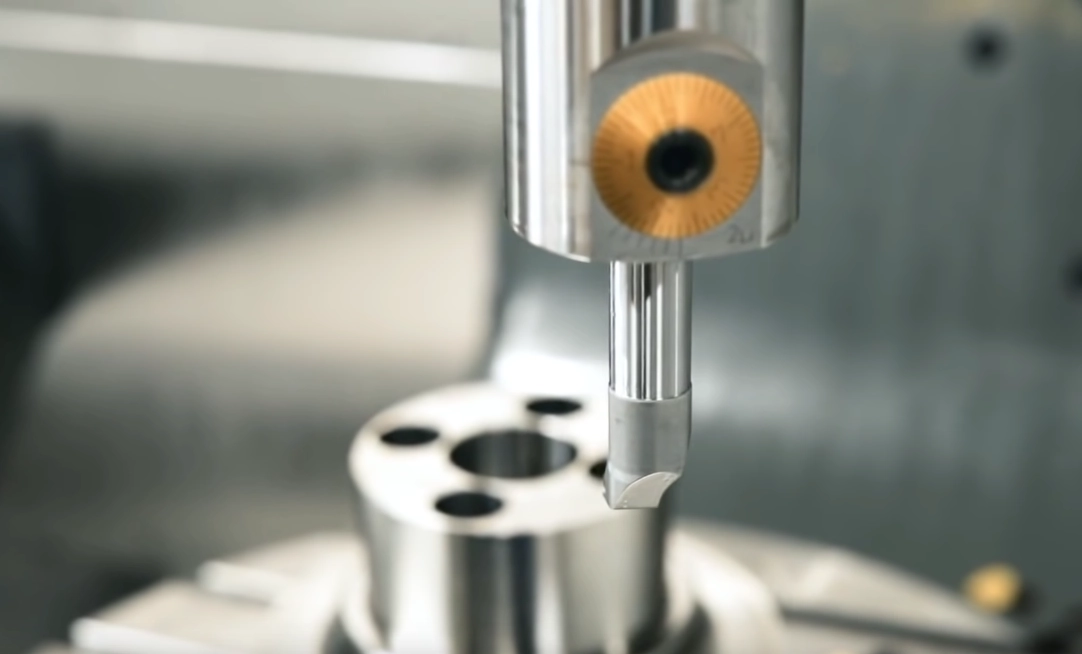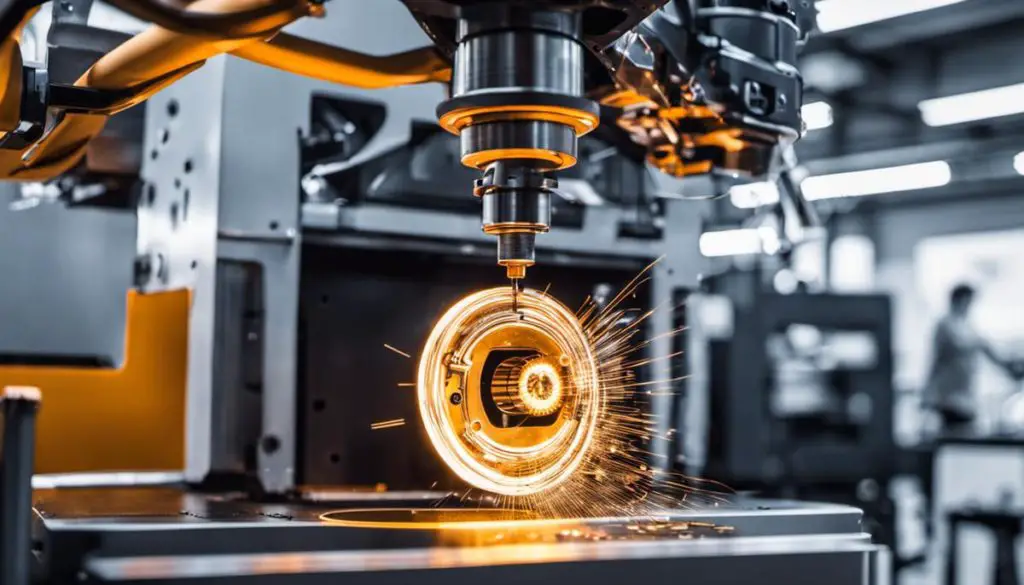As we stand on the cusp of the fourth industrial revolution, the convergence of the digital and physical world is only becoming more pronounced. Central to this transformative era is CNC (Computer Numerical Control) machining, a manufacturing process where pre-programmed software dictates the movement of factory tools and machinery. This article embarks upon an exploration into the world of CNC machining – its esoteric mechanics, crucial role in diverse industries, its interface with advanced technologies such as Artificial Intelligence (AI), and Machine Learning (ML). Dive in to discover how AI and ML are making waves in the realm of CNC machining, their potential, and the challenges they might face, and a glimpse into what the future of CNC machining with these advanced technologies may look like.
Key Takeaways from this article:
- AI & ML Integration: CNC machining is evolving rapidly with the integration of AI and Machine Learning, leading to transformative manufacturing processes.
- Big Data’s Role: CNC machines generate vast data, which, when analyzed by AI and ML, enhances predictive maintenance and performance optimization.
- AI Benefits: AI in CNC machining offers fault detection, decision-making, and proactive problem-solving, paving the way for autonomous manufacturing.
- ML’s Impact: Machine Learning enables autonomous optimization, predictive maintenance, and anomaly detection in CNC machining.
- Sustainability: AI and ML promote energy-efficient and sustainable CNC machining practices.
- Future Outlook: The fusion of AI, ML, and CNC machining promises comprehensive automation, predictive maintenance, and enhanced precision in manufacturing.
- Transition Challenges: While the potential is immense, challenges like specialized knowledge requirements, cybersecurity threats, and investment costs exist in the path of AI-enabled CNC machining.

- Key Takeaways from this article:
- Understanding CNC Machining
- Impact of AI on CNC machining
- Machine Learning in Digitization of CNC
- Future of CNC Machining with AI and ML
- FQA
- What is the significance of integrating AI and Machine Learning with CNC machining?
- How does the role of big data play into the CNC-AI integration?
- What benefits does AI bring to CNC machining?
- How is Machine Learning transforming CNC machining?
- What are the sustainability implications of integrating AI and ML with CNC machining?
- What does the future hold for CNC machining with AI and ML integration?
- Are there challenges in transitioning from traditional CNC machining to AI-enabled CNC machining?
Understanding CNC Machining
The Fusion of CNC and AI: The Unprecedented Transformation
The rapid expansion of technology has paved the way for countless revolutionary processes and methodologies, which have indeed been propelling industries forward. One such integration we’re witnessing is the marriage of two pivotal sectors—CNC (Computer Numerical Control) machining and Artificial Intelligence/Machine Learning (AI/ML). The inherent features of CNC machining make it a perfect candidate for catalyzing this unprecedented technological transformation.
Precision, Efficiency, and Reproducibility: A Triad for Success
Firstly, CNC machining boasts of its extreme precision, core efficiency, and impressive reproducibility. By automating and controlling every movement in the production process, CNC ensures minimal errors and stellar consistency. Combining these traits with AI’s power to incredibly enhance machine capacity, analyze generated data, and constantly learn, it’s plausible to envision levels of productivity and efficiency that have been just dreams until now.
The Role of Big Data in CNC-AI Integration

The role of big data can’t be dismissed in this fusion either. CNC machines generate an immense amount of precise data points, which can be massive fodder for AI and ML algorithms. This data, when analyzed and leveraged appropriately, allows the machines to perform predictive maintenance, optimize performance, anticipate complications, and ultimately refine the manufacturing process exponentially.
Programmable and Highly Adaptable
Another promising aspect of CNC machines is their programmable nature. Machines can be instructed to carry out complex tasks, making it easier to integrate machine-learning processes. The more these machines operate under varying circumstances, the better they can learn and adapt, thanks to AI’s real-time adaptability and flexibility.
Fault Detection and Self-correction: A Step Towards Futuristic Manufacturing
CNC machining can greatly benefit from AI’s power of fault detection and corrective decision-making. Machines equipped with AI can analyze data to pinpoint flaws proactively, drastically reducing fault rates and downtime. But not just that, it also opens up the potential for machines to rectify errors automatically—a step towards futuristic, autonomous manufacturing.
The amalgamation of AI and CNC machining isn’t merely about optimizing current methodologies—it’s about shaping the future of the manufacturing industry. Through enhanced precision, increased productivity, and powerful adaptability, this integration signifies a quantum leap forward, setting the pace for a new era of a technologically advanced world. The coalescence of these two pivotal components will unquestionably redefine the paradigms of manufacturing, and rightfully so. As with any tech enthusiast, the excitement for this seamless fusion and its limitless potential is palpably high, and for a good reason. After all, it isn’t every day we get to witness the precipice of a full-blown technological revolution.
Impact of AI on CNC machining
The Progressive Impact of AI on Traditional CNC Machining
In the continuously evolving technological landscape, the integration of Artificial Intelligence (AI) into Computer Numerical Control (CNC) machining is a revolutionary stride. The blend of AI with CNC machining ushers in a new era of industrial technology, maximizing production efficiency and minimizing human error.
Propelled by the power of Machine Learning (ML), this game-changing integration marks a paradigm shift in the automation industry. AI-driven CNC machines can now learn from their operational experiences, generating a level of manufacturing intelligence previously unimaginable.
Beyond the already significant precision enhancements and efficiency improvements, the CNC-AI union introduces another element: proactive problem-solving capacity. In-built AI systems can analyze historical performance data, identify operational faults, and preemptively rectify them, thus alleviating previously undiagnosed bottlenecks and averting untimely machine breakdowns.

Moreover, the consolidation of AI techniques with traditional CNC machines has led to the emergence of a highly programmable system. The unprecedented adaptability of cutting-edge CNC machines enables them to swiftly adjust to varying machining parameters, ultimately leading to the production of higher-quality products.
Another big leap in CNC machining post-AI intervention is the effective employment of big data. The seamless synchronization of AI with CNC allows the machines to collect, analyze, interpret, and use large data sets, thus propelling the decision-making process. Consequently, the machining efficiency is significantly bolstered, leading to amplified productivity.
With the future seemingly headed towards a more AI-driven environment, the implications of the symbiotic CNC-AI relationship are expected to skyrocket. The manufacturing processes stand to gain exponentially from this technological collaboration, as more elaborate applications for this partnership are discovered. From on-the-fly modifications to automated quality control, the possibilities are boundless and exhilarating, fueling an air of enthusiasm and optimism in tech circles.
Bringing about a transformational change in the world of fabrication, the AI revolution in CNC machining goes above and beyond just efficiency improvements. It is about the creation of an intelligent machining ecosystem where machines can learn, adapt, improve, correct themselves, and eventually provide unprecedented levels of precision, efficiency, and productivity.
While the transition from traditional CNC machining to AI-enabled CNC machining may seem challenging, it is essential to remember: that technology advances not to complicate, but to simplify. The incredible potential and exciting possibilities that lie within the realm of AI-CNC integration pave the way for a future of innovations, a future where the only constant is change.
In conclusion, AI is revolutionizing traditional CNC machining by pushing the boundaries of what is possible, arming engineers with new tools, and setting an invigorating pace for the world’s technological future. The ripple effects of this ongoing revolution have been extraordinary already, and the best is yet to come. The coming years can only add more chapters to this exciting story of machines that learn.
Machine Learning in Digitization of CNC
The Accompanying Advantages of Machine Learning in CNC Machining
While the integration of artificial intelligence into CNC machining has already stirred the tech world, it’s the incorporation of ML algorithms that add seminal value. By imbibing machine learning algorithms into CNC machining, we embrace a new era of manufacturing that is markedly different from conventional modalities.
An immediate advantage of this integration is the autonomous optimization of machining parameters. ML algorithms can be trained to parse large amounts of data collected during the machining process, which can then be used to optimize tool paths, cutting speeds, and feeds. This isn’t just about small incremental changes but a system-wide revolution that has viably drastic effects on productivity, cost-efficiency, and overall output quality.
Next, the inculcation of machine learning brings CNC machining into the predictive maintenance realm. Through constant condition monitoring and predictive trend analysis, these machines can alert operators about an oncoming failure or malfunction well in advance. This proactively mitigates the risks associated with sudden machine breakdown and preserves the machine’s lifespan, thereby proving efficient for long-term operations.
Through the utilization of machine learning algorithms, it becomes possible to shift toward lights-out manufacturing. With the capability to continually learn and improve, CNC machines can operate without manual intervention, leading to a significant reduction in labor costs. It also paves the way for around-the-clock production, completely changing the landscape of modern manufacturing in terms of capacity and profitability.
An important aspect of machine learning, anomaly detection, when implemented in CNC machining, serves as an instrumental tool in maintaining high-quality output. It quickly identifies deviations from the predefined production standards and automatically applies corrective action, ensuring minimal disruption and waste.

Lastly, for an industry often criticized for its exhaustive use of resources, machine learning algorithms provide a path toward sustainable practices. ML can manage energy consumption in CNC machining by intelligently scheduling tasks and reducing idle times. This results in lower energy bills, increased sustainability, and a crucial step towards greener manufacturing.
There is no doubt that machine learning algorithms in CNC machining are transforming the industry. From autonomous optimization to predictive maintenance, lights-out manufacturing, anomaly detection, and sustainable operations, they are raising the bar for what is possible. One thing that is clear; this is no passing trend. Machine learning algorithms and CNC machining are entwined and together, hold the exciting potential to redefine the manufacturing industry.
In a nutshell, the integration of machine learning in CNC machining is not a ‘nice-to-have’, but a ‘need-to-have’. The journey may be nascent, but the future is bright and limitless. This symbiosis of machine learning and CNC machining is not just a wave of a digitized future, but a robust stride towards an industrial revolution that is undoubtedly thrilling.
Future of CNC Machining with AI and ML
Reshaping the Future of CNC Machining with AI and ML
Following the successful integration of Artificial Intelligence (AI) and Machine Learning (ML) into Computer Numerical Control (CNC) machining, the next frontier appears to be comprehensive automation. One of the intriguing possibilities is the autonomous optimization of machining parameters. With the aid of AI and ML, CNC machines could independently determine optimal settings like cutting speed, feed rate, and depth of cut, considering the material to be machined and its properties. This means more predictability, accuracy, and efficiency – a future where manual parameter setting could be a thing of the past.
Another trending concept worth noting is predictive maintenance, which plays a vital role in reducing machine downtime and increasing operational efficiency. ML algorithms can analyze historical failure patterns in CNC machines and predict when the next one might occur. This advanced level of forecasting decreases unexpected interruptions, promotes efficient resource management, and extends the life of the machines.
As for lights-out manufacturing -once a futuristic concept- the advancements in AI and ML have opened its gates to reality. The vision is a streamlined, human-independent production pipeline where machines work around the clock. This is not just cost-effective but also enhances production speed and capabilities, proving invaluable to both small and large-scale manufacturing enterprises.
The addition of anomaly detection algorithms is another gem in the AI-CNC crown. For instance, CNC machines can detect any atypical behavior during the machining process under the vigilance of AI. This could be an unconventional tool movement, an unexpected increase in temperature, or an unusual sound. Early detection of these anomalies ensures better product quality and minimizes waste.
In terms of sustainability, AI and ML integration enable efficient resource management and more green operations in CNC machining. Be it energy consumption, material utilization, or waste reduction – everything undergoes an overhaul. With climate change being a global concern, a movement towards more sustainable manufacturing practices is not just a preference but a necessity.
This transformative wave is reshaping the entire manufacturing industry. The seamless integration of machine learning in CNC machining fosters an innovation-friendly environment, introducing new dimensions to the sectors. This evolution is likely to boost the efficiency, effectiveness, and versatility of manufacturing processes, granting businesses a competitive edge.
However, the true potential of AI and ML in CNC machining is yet to be fully explored. Given their current trajectory and the momentum of technological advancement, the convergence of these aspects points towards an exciting future. While we usher in this new era of smart manufacturing, the question is not whether AI and ML will redefine the future of CNC machining but how. The answers unfold as we journey further into this era of technological fusion. The reality of AI-powered CNC machining is here, and it is revolutionizing the manufacturing landscape for good. Refusing to embrace this revolution is not an option; it’s a matter of staying relevant on the global manufacturing stage.
Enveloped in a swiftly changing technological milieu, CNC machining is set to embrace remarkable evolutions with artificial intelligence and machine learning. From making machining operations more efficient, smart factories, and self-correction to the discovery of new machining methodologies, AI and ML adoption in CNC machining heralds a future with amplified precision and intriguing job roles. Yet, like every innovation, there are challenges that lie in the path of integration. However, if the current pace of evolution is anything to go by, the narrative of CNC, AI, and ML interplay is poised to be a riveting saga of innovation. Jobs may shape-shift, but the march towards ubiquitous digitization is unstoppable, and with it, CNC machining is set to mutate into a smarter and more sophisticated beast.

